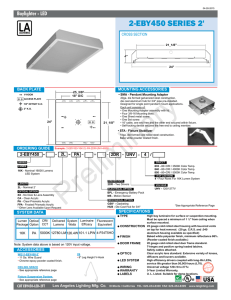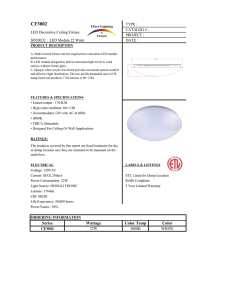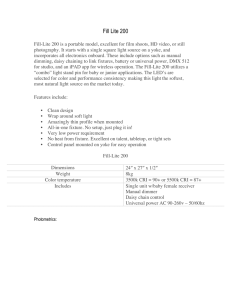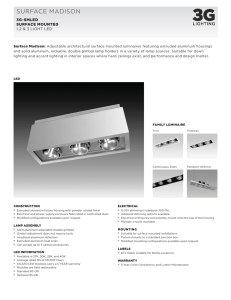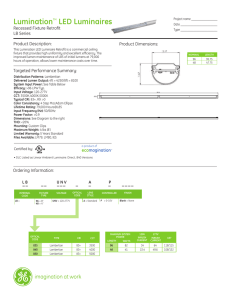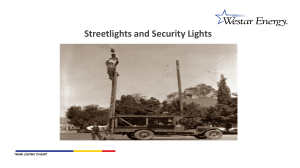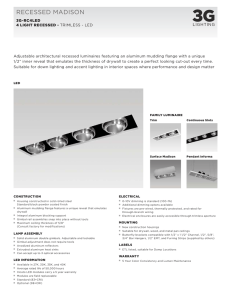LED Fixtures 101 - CapitalTristate Advantage
advertisement
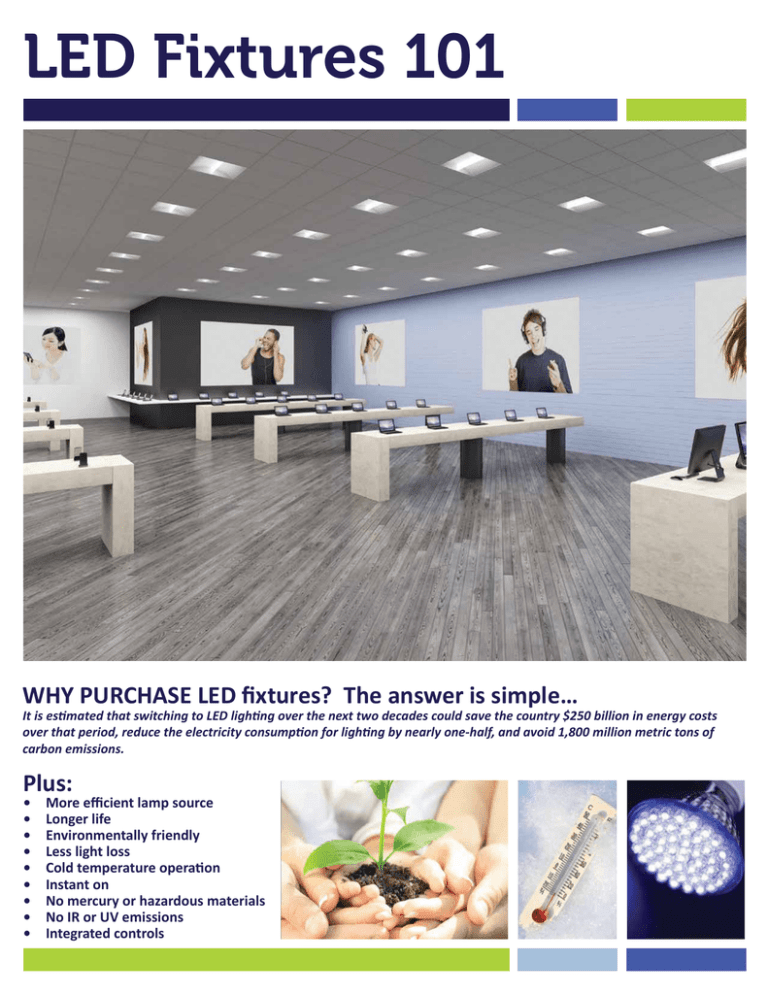
LED Fixtures 101 WHY PURCHASE LED fixtures? The answer is simple… It is estimated that switching to LED lighting over the next two decades could save the country $250 billion in energy costs over that period, reduce the electricity consumption for lighting by nearly one-half, and avoid 1,800 million metric tons of carbon emissions. Plus: • • • • • • • • • More efficient lamp source Longer life Environmentally friendly Less light loss Cold temperature operation Instant on No mercury or hazardous materials No IR or UV emissions Integrated controls What is an LED? LED stands for Light Emitting Diode. An LED is a semi-­conducting device that produces light when an electrical current flows through it. It is a light source, just like HID, fluorescent, incandescent, etc. SSL stands for Solid State Lighting. SSL is an umbrella term encompassing different types of technologies. Since LED systems use this technology, the term SSL and LED are often used interchangeably. A similar comparison can be drawn when using the terms “lamp” vs. “light bulb”. The LED system consists of several components. The LED is the light source. The LED driver is a self-contained power source that functions like a fluorescent ballast. It provides proper voltage and regulates current flow. Image credit: Green Creative www.gc-lighting.com Multiple LEDs are combined into arrays. The luminaire (or fixture) is the final component. This is the surrounding material constructed for optical and thermal control of the overall system. Luminaire LED Driver LED Chip LED Array LED Definitions Color Temperature – The color appearance of the light. This is measured in the integrating sphere, which analyzes the emitting wavelength to determine the color temperature. Incandescent and halogen sources have a warm white color temperature of 2700K, while fluorescents and LEDs are available in all colors of light, such as warm white (2700K-3000K), natural white (4000K) and day light (6500K). Warm Neutral Cool Natural Daytime Atmosphere Soft, Comfortable, Relaxing Balanced Clean Bright, Simulates outdoors Crisp, Refreshing Kelvin 2700K - 3000K 3500K 4100K 5000K 6500K CRI Color Rendering Index (CRI or Ra) – CRI measures the ability of a light source to accurately reproduce colors and is measured on a scale from 0 to 100. Natural light has a CRI of 100 and is what all light sources strive to replicate (left picture). A CRI of 65 is considered poor (right picture), while a CRI of 80 is considered good. Halogen and incandescent sources have CRIs close to 100, while fluorescent sources are usually around 80. ENERGY STAR requires a CRI of 80 for integral Left picture: 80 CRI (Good) LED lamps. Right picture: 65 CRI (Poor) DLC (Design Lights Consortium) – The DLC Qualified Products List (QPL) serves efficiency programs and the lighting industry by maintaining the leading public list of high-quality, high-efficiency LED products for the commercial sector. ENERGY STAR – A government program set up to promote environmental protection through energy efficient products and practices. Products that have been qualified by ENERGY STAR have passed strict requirements and can be considered energy efficient and reliable. Lighting Facts Label – A label that displays information, such as: Light output/Lumens, Watts, Lumens per Watt/Efficacy, IESNA LM-792008, LED Lumen Maintenance, Model Number, Type, Brand, Color Rendering Index (CRI), Correlated Color Temperature (CCT), and Product Warranty. Lumen – A measure of the total “amount” of visible light emitted by a source, defined as a unit of luminous flux. Lumen Maintenance – A comparison of the amount of light produced from a light source or from a luminaire when it is brand new to the amount of light output at a specific time in the future. The remaining output at the specified time is expressed as a percentage of the initial lumen output. Lifetime – The reported life of an LED Ambient Temp TM-21 Lumen Maintenance (60,000 Hours) Theoretical L70 (Hours) 25°C >94% >350,000 40°C >93% >250,000 50°C >90% >170,000 component or system is defined as the operating time (L, in hours) for the component or system to reach two performance criteria: L70 (Theoretical) – estimated time (in hours) to 70% lumen maintenance (70% of initial light output); and TM-21 – projected lumen maintenance (% of initial output) at 60,000 hours. Ambient temperature affects the L70/TM-21 rating. Always check the specifications of the product for lumen maintenance variance based on this factor (see chart). Foot-candle – A unit of measure of the intensity of light falling on a surface equal to 1 lumen per square foot. It has been replaced in the International System (SI) by the candela (1 lumen per square meter). Abbreviation : FC image credit: www.lightingfacts.com Efficacy – Lumen per Watt (LPW or lm/W) is a measure of how well a light source produces visible light. It is the ratio of luminous flux to power. LED fixtures are selected by their efficacy, not the lamp source lumen output. Ill um Lumens in ce e nc an a in m Lu Foot-Candles Utility Rebates Custom Rebate: How is it calculated? It is based on the actual energy savings by comparing the formal installation with the new one. Total rebate amount is based on annual kWh savings, such as $0.1/kWh annual kWh saved on the full installation. What is the process? After filling out an application, it will usually require a pre- and postinstallation visit from a program representative. Prescriptive Rebate: How is it calculated? It is a fixed amount per lamp or per fixture, such as $20/MR16. What is the process? After filling out an application, it will be necessary to provide proof of purchase and installation. Utility Websites for Rebate Forms: BGE http://bit.ly/1KBnJ38 DCSEU (DC Sustainable Energy Utility) http://bit.ly/1DddnUa DELMARVA POWER http://bit.ly/1DddsHC DOMINION POWER http://bit.ly/1Dddtvc Met-Ed, Penelec, Penn Power, West Penn Power http://bit.ly/1U9DmjW PECO http://bit.ly/1eDjUfo PEPCO http://bit.ly/1INZVJ0 POTOMAC EDISON http://bit.ly/1VPHhEm PPL Electric http://bit.ly/1INZWN5 SMECO SMALL BUSINESS http://bit.ly/1IlG9h4 SMECO BUSINESS SOLUTIONS http://bit.ly/1U8NQDD What you need to know to select the correct light fixture for your project. When you are ready to purchase the light fixture, determine the part number: Example: HBLED-LD4 12 (12000 lumens)-UNV-L840(4000K)-ED1-U Fixture Style Lumen Output Important Questions to Answer: • • • • • • • Voltage CRI 120V-277V Color Temperature Driver Packaging New or Retrofit Project? Literature provided by If Retrofit/Replacement: What is the wattage/lamp/fixture you’re replacing? CapitalTristate and Eaton Lighting Is there a product that better fills the needs of the customer? If New: Room dimensions (L x W x H)? What tasks are performed in this space? Light Levels Required? What foot-candle level is needed for tasks in the space? ***This answer determines the required lumen rating of fixture What is the color temperature required? Is Dimming required? Rebate Available? Do fixtures qualify? NOW YOU CAN FEEL CONFIDENT PURCHASING LED FIXTURES! 20150827
